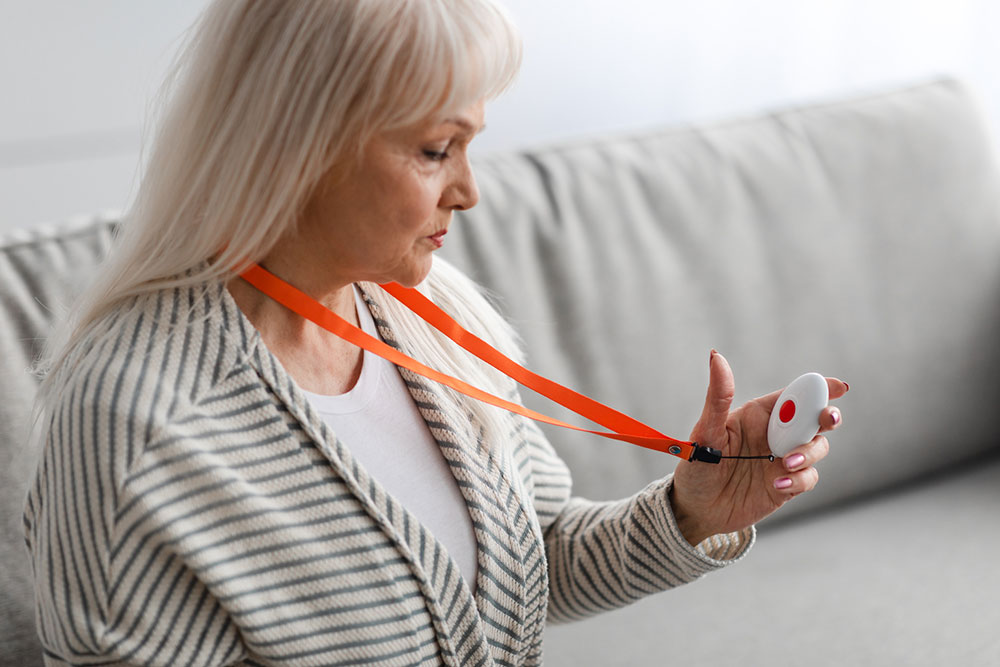Panic Buttons for Seniors – Types, Benefits, and Cost
Older adults might be home alone for various reasons. For instance, they may prefer to live independently, or their family members could be away for work. While they may have no trouble living alone, there is always the risk of hazards, such as falls or unexpected health complications. In such instances, panic buttons, which are devices either worn or placed in an easily accessible spot, could come in handy for contacting emergency services or caregivers.

Purpose of a panic button
Seniors living alone or left at home without supervision for a few hours might need a healthcare-assistive device, such as a panic button, to deal with emergencies. Also known as a personal alarm, panic alarm, or emergency calling system, a panic button helps seniors contact emergency services immediately as soon as they feel uncomfortable, experience a fall, or encounter other dangerous situations. These devices offer peace of mind to seniors and their families, knowing that help is just a push of a button away.
Types
Seniors can choose from several types of panic alarm systems. These systems can be portable, worn on the wrist or neck, or installed as a button or pull cord in the house for emergencies.
- Basic alarms: These devices make a loud noise to alert people nearby in case of an urgency or emergency.
- Monitored alarms: This type can alert a 24-hour monitoring service when something seems to be wrong.
- Fall detectors: Seniors could use fall detectors to alert family members or emergency services if they fall. The detector can be built into the alarm or be a standalone device.
- GPS tracking alarms: If necessary, family, emergency services, and caregivers could use GPS tracking alarms to determine the senior’s approximate or precise location.
Benefits
1. Good battery life
Many devices designed to help seniors alert healthcare services come with rechargeable batteries that may last months. Some types are paired with disposable batteries that may last years, eliminating concerns about whether the device will shut down in times of need.
2. Quicker emergency recognition
An elderly individual may experience falls and suffer severe injuries even at home. An emergency panic button could detect falls and contact emergency services, supervisors, and family members faster, helping avoid delays in diagnosis and treatment.
3. Better sense of security
Panic buttons for seniors are typically small and portable. Some can be worn around the neck, while others are meant for wrists. The devices allow older adults to set off the alarm if they require assistance. So, the buttons may give seniors a better sense of security and reassure them that their needs won’t be ignored and will be addressed quickly.
4. Less anxiousness over accidents
Seniors with restricted flexibility and poor balance could be worried about them experiencing falls. A panic alarm could help reduce this worry. It could reassure them that they can relax even if they live alone. It would also allow them to exercise without worrying too much about accidents.
5. Peace of mind
The healthcare device not only makes an older adult feel safe but also benefits their family members, guardians, and caregivers. Knowing that the senior can use the panic button in an emergency will bring peace of mind to everyone responsible for the senior’s safety. Caregivers will receive a signal if the senior encounters an emergency. They can also log into the monitoring system to track the older adult’s activity, such as whether they take their prescriptions on time, maintain regular sleep schedules, and follow other routines.
Cost
Seniors or their family members looking to buy a panic button for emergencies should know the cost of various device types. The typical cost of a healthcare alert system is about $20 per month and about $240 a year. Some products have one-time fees ranging from $50 to $350 and may include upfront activation and programming fees of up to $200, depending on the product. Other factors that may influence the cost of a panic alert system for seniors include emergency monitoring, equipment, activation, and protection plans. Moreover, the purchase of additional devices, add-on features, and lockboxes could affect the price of the button. Providers may also allow seniors to rent equipment for at-home systems but require one to purchase on-the-go equipment for an added cost.
Coverage
Traditional Medicare (Part A and Part B) does not cover healthcare alert systems like panic buttons. So, one could consider other ways to save on device purchases.
1. Medicare Advantage
While plans may differ, various Medicare Advantage plans might cover partial or the complete cost of the device. One could check with their insurance provider if the coverage is available.
2. FSA and HSA
One can use funds from the Flexible Spending Account (FSA) or Health Savings Account (HSA) to pay for the device. These accounts let one set aside money before taxes to pay for healthcare expenses and are typically available through employers. But there are limitations, such as FSA funds cannot be utilized after one has retired, and an individual can also not contribute to an HSA if enrolled in Medicare.
3. Seasonal discounts
Healthcare companies that sell panic buttons may offer discounts around holidays or other times of the year. They may waive equipment fees or offer a free service for a month.
One should consider these and other payment options before buying a panic button.











